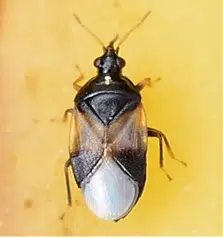
My name is Alyssa and I started working at the Holden Arboretum as a nursery technician in January. I help with all parts of plant growing, but my specialty is pest management. I was brought on to help increase the effectiveness and sustainability of the nursery’s pest management program.
Pests are a problem in the nursery just as they can be for plants growing outside. The greenhouse provides an optimum growing environment for plants: warm temperatures, protection from the weather, and freedom from predators. Unfortunately, these same conditions are also optimum for many pests!

Frankliniella occidentalis, or the Western Flower Thrips, is greenhouse pest which damages plants and spread disease. By Frank Peairs, Colorado State University, Bugwood.org – CC BY 3.0, https://commons.wikimedia.org/w/index.php?curid=11272182
To better manage pests, we are developing an integrated pest management (IPM) program for the Holden Arboretum nursery. IPM is a pest management approach which combines many methods of pest control such as changing the growing environment, trapping insects, and applying beneficial insects so that chemical control can be used less often.
One practice we are putting in place for our IPM program is biological control. Biological control is the use of beneficial organisms, such as predators, parasites, and pathogens to control pest insects. Gardeners may be familiar with ladybugs and green lacewings, which are predatory insects that consume pests in the landscape. These are just a few of the many beneficials greenhouses and nurseries can purchase from insect-rearing companies.
CC BY-SA 3.0, https://commons.wikimedia.org/w/index.php?curid=4606

One of the biological control agents we released is the minute pirate bug, also known as Orius or the insidious flower bug. These small bugs are voracious predators of thrips, which are tiny plant pests which feed on flowers and leaves and can spread disease. We saw a substantial decline in thrips after applying Orius. Orius are such good predators that they will wipe out their entire food source! That’s why we have started to grow flowers like marigolds and alyssum to place around the greenhouse. Orius will feed on pollen when their prey is scarce. The flowers will help sustain Orius populations in the greenhouse so we can continue to have good control of thrips and other pests.

Orius Insidiosus, or the minute pirate bug, is a voracious predator of thrips and other pests. By Ryan Hodnett – Own work, CC BY-SA 4.0, https://commons.wikimedia.org/w/index.php?curid=74980312

Alyssa Zearly
Nursery technician
Alyssa Zearley is a nursery technician at Holden Forests & Gardens. She is developing an integrated pest management program for the arboretum’s nursery. Alyssa has a M.S. in Environment and Natural Resources and a B.S. in Plant Health Management from The Ohio State University.













